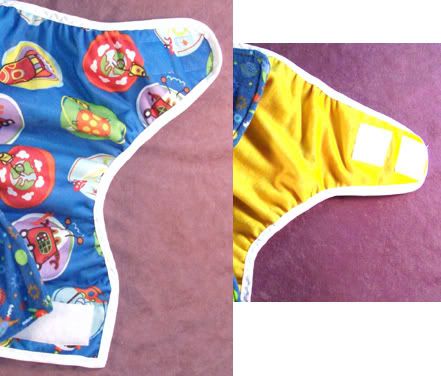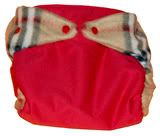But the waterproof layer is also available on its own to be used to provide wetness protection to a separate absorbent diaper underneath. Called a diaper cover, there are many options in style and fabric, allowing for great versatility in a "stash". Diaper covers that are not saturated or soiled can be aired out and reused several times before washing, meaning that fewer waterproof covers are needed for the diapers that go underneath. And having a separate cover also provides a secondary barrier to baby diaper messes.
We'll take a look at diaper covers in groups of the fabrics made to use them. Today, we'll discuss the most popular waterproof choice.
Polyurethane Laminated Fabric, aka PUL
A safer and more comfortable alternative to the vinyl "plastic pants" of the past, PUL is one of the most popular diaper cover fabrics. PUL is made by laminating polyurethane film to fabric, and the fabric was originally used for medical "splashguard" barrier clothing and surgical drapes that can be autoclaved (sterilized by high-pressure steam) and reused. PUL is one of the specialty diaper-making fabrics that are only found online. The polyurethane film comes in two thicknesses, 1mil or 2mil. The "waterproofness" is about the same in the two varieties, but 1mil is more stretchy and drapey, while 2mil is stiffer.
The most commonly available PUL is made with 100% polyester knit fabric, and provides the greatest waterproofness. But other fabrics like nylon and even cotton can have the polyurethane film laminated to them. Natural fibers that have been laminated will be more prone to "wicking" or moisture transference from the inside of the cover to the outside. There are methods of minimizing this effect, including using seam sealing tape to close sewing holes or using fold-over elastic instead of a turn-and-topstitch style.
Because of the "sticky" feel of the polyurethane laminate on the back side of the fabric, PUL is best suited to diaper covers that are lined with another fabric (often polyester fleece, suedecloth, or another layer of PUL with the fabric face out) made in the "wrap" style, and fastened with hook-and-loop or snaps. The excellent waterproofness of PUL comes at a trade-off: it is not a very "breathable" fabric, and can be hot during the summer or in hot climates.
 This diaper cover from Artisty Baby at BabyDearest is made with 1mil polyester PUL lined with polyester suedecloth and bound with 1" fold-over elastic. It fastens with TouchTape brand hook-and-loop.
This diaper cover from Artisty Baby at BabyDearest is made with 1mil polyester PUL lined with polyester suedecloth and bound with 1" fold-over elastic. It fastens with TouchTape brand hook-and-loop.Diaper covers made with PUL can also be done in turn-and-topstitch style, where the inner and outer layers are first sewn right-sides-together and then turned right-side-out through a hole. The diaper cover is then topstitched, making sure to close the turning hole.

This diaper cover from Fruit of the Womb Diapers is made with 1mil polyester PUL with "wing" accents and lining of polyester microfleece. It is finished turn-and-topstitch style, and fastens with polyacetal resin (plastic) snaps.
The recommendation?
PUL diaper covers made with polyester are an excellent choice for car trips, overnight, or heavy wetters, because they provide the greatest level of moisture protection. Cotton that has been laminated makes cute daytime covers, but will be prone to wicking and is not recommended for extended wear.
The pattern suggestions?
On the for-sale pattern side, everything-included kits from Diaper Kit or Kayla's Cloth Kits are again recommended. The Little Comet Tails Little Starter and Darling Diapers patterns are also popular, versatile patterns that include instructions for assembling a variety of styles from different fabrics.
On the for-free pattern side, try the Miala hook-and-loop fastening turn-and-topstitch pattern, or the Chloe Toes side-snapping FOE-bound pattern.
No comments:
Post a Comment